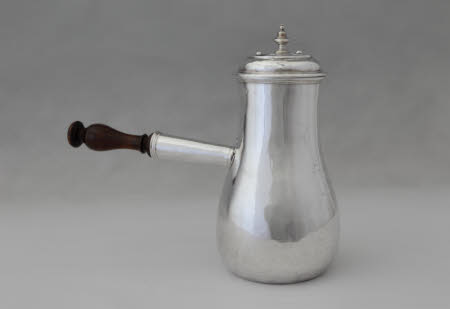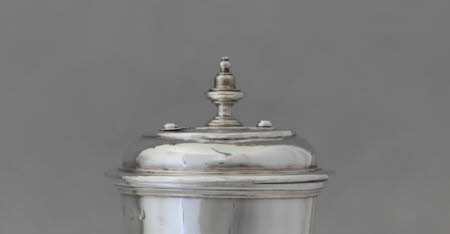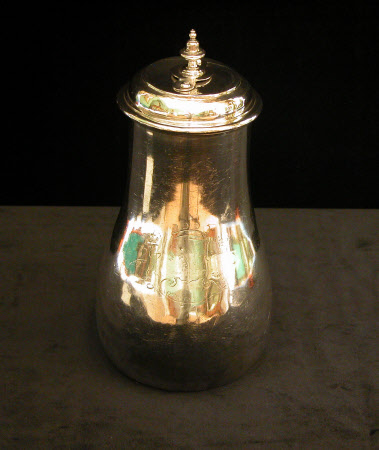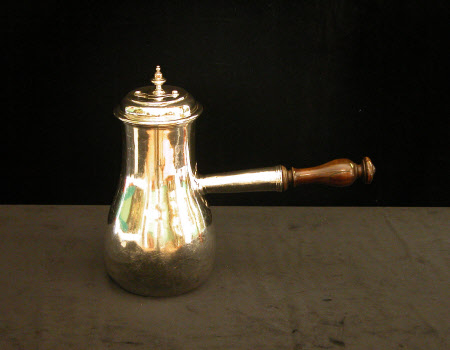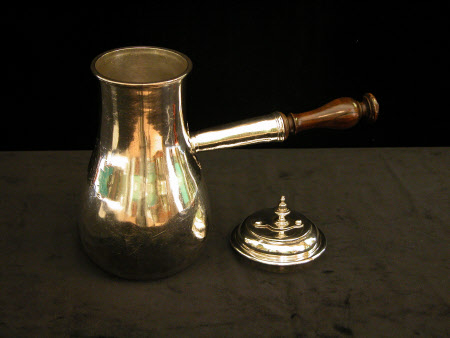Chocolate pot
Pierre Platel (b. c.1664, d.1719)
Category
Silver
Date
1704 - 1705
Materials
Silver, Wood
Measurements
24.8 x 28.9 cm; 12.1 cm (Diameter); 833 g (Weight)
Place of origin
London
Order this imageCollection
Ickworth, Suffolk
NT 852070
Summary
Britannia silver chocolate pot by Pierre Platel, London, 1704/5 (?) The elongated pear-shaped or ‘bellied’ (the 18th century name for the pear-shape) body is raised and has an applied, stepped moulding at the lip. There is no spout. A tapering, seamed stem is soldered to the side of the pot, the joint disguised by cut-card work. It terminates in an applied stepped moulding and acts as a socket for the turned fruitwood handle. The detachable domed and stepped lid is raised and has an applied lip moulding and a seamed bezel. A hole is cut in the centre of the top for the insertion of a mill or stirring rod (sometimes also called a molinet) and is covered by a simple flat, shaped plate rotating on a fixed staple riveted through the lid. The plate, to which is soldered a cast baluster finial, has an incision forming a hook which closes over a second riveted staple. Heraldry: Engraved on the body of the pot, opposite the handle, is a shield bearing the impaled arms of Hervey and Felton with the Hervey supporters and motto and a baron’s coronet for John Hervey, 1st Baron Hervey (cr. 1703, subsequently 1st Earl of Bristol). This is the only surviving example of the 1st Earl’s engraved arms as Lord Hervey, all other pieces having been re-engraved by the 2nd Earl. Marks: At top of body, beneath rim (very rubbed), maker’s mark ‘PL’ beneath a star and a crown and above a fleur de lis (Arthur Grimwade, London Goldsmiths 1697-1837, 1990, no. 2200), Britannia, lion’s head erased, date letter ‘J’ (?). On neck of lid, maker’s mark as above, twice (partial). Scratchweight: none.
Full description
This is an object which bears manifest signs of intensive use and it is quite clear from his correspondence and account books that John Hervey, 1st Earl of Bristol, had a great fondness for drinking chocolate. The first mention in the accounts of the expensive and highly desirable comestible is made on the 16th May 1711 when he paid £12 10s to ‘Mrs Hyde for 50 Pounds of Chocolate’ and just a few months later, on the 21st August 1711, ‘Mrs Ryff ye Dutch woman’ supplied another 20 pounds or so.[1] Consumption, which initially settled to about 50 pounds a year, rose to 100 or more in the early 1720s and Lord and Lady Bristol are revealed as habitually consuming it with breakfast in letters to each other of the time. Writing on the 6th September, 1721, Lord Bristol railed against his ‘ungovernable’ servants at Ickworth and wrote of hounds causing chaos in the kitchen and the bread being ‘left all night in the oven and utterly spoyld, and not so much as a toaste left for me to eat with my chocolate’. Lady Bristol, two years later and on her way to Bath, wrote on the morning of the 12th September ‘tis 8 a clock, & I am just going to drink your dear health in chocolate, and then set out.[2] The Earl continued to partake for the rest of his life. In July, 1746 his daughter-in-law Lady Hervey brought chocolate with her from London when she visited him at Ickworth and on the 5th January, 1751, just two weeks before his death at the age of 85, he paid Mrs Mary Pitts £4 19s ‘for 11 pounds of Vanillo Chocolate at 5s p[er] pound & 11 pounds of plain Do at 4s p[er] pound’.[3] Instructions for making chocolate varied but the no-nonsense recipe recorded in the Experienced English House-keeper of 1769 by Mrs Raffald, who had served at Arley Hall in Cheshire, could well have been followed in the 1st Earl’s still room: 'Scrape four Ounces of Chocolate and pour a Quart of boiling Water upon it, mill it well with a Chocolate Mill, and sweeten it to your Taste, give it a boil and let it stand all Night, then mill it again very well, boil it two Minutes, then mill it ‘till it will leave a Froth upon the Top of your Cups'.[4] The chocolate would have been supplied in solid blocks and as the cocoa butter was not extracted stirring, or milling, was a key part of preparation to prevent coagulation, and continued to be required during serving, thus the need for the hole in the cover. As evidenced by Lord Bristol’s 1751 purchase, chocolate could also be acquired ready flavoured and, in addition to vanilla, cinnamon was also added.[5] Although it was primarily drunk, chocolate was also used sparingly for flavour and colour in dessert dishes such as chocolate puffs which were a form of meringue.[6] The very unusual form of the Ickworth chocolate pot, without either feet, hinged lid or pouring spout and being of a larger capacity than the norm, suggests that it was used in the initial preparation of the drink in the still room, as well as in serving. There is only one comparator in silver currently known to survive and that is the Dysart pot of 1738 by Paul Crespin now in the Ashmolean Museum.[7] Timothy Schroder ponders whether such a model might have been intended to replenish a smaller, more conventional chocolate pot and although there is no evidence of a second pot having existed at Ickworth, the 1st Duke of Chandos does seem to have had such an arrangement at Cannons. In addition to the chocolate pot recorded with tea and coffee silver in the Drawing Room there was amongst the plate in the pantry ‘1 New Chocolate pott 40[oz].14[dwt] + 1 trivett 4[oz.6[dwt]’, trivet being used by the inventory maker to mean the frame of a lamp.[8] It may have been employed in the manner shown in Jeanne Etienne Liotard’s ‘La Chocolatière’ (private collection) where a lamp in a circular frame is on the floor by the side of the chocolate drinker. There is no specific reference to this pot in the 1st Earl’s accounts, nor are there any purchases of chocolate prior to 1711.[9] It may therefore be that the piece was not acquired new and that it reached the Herveys around 1711, either in response to their enthusiasm for the drink or as the spur to it. If the latter it could well have been amongst the 115 ounces of plate acquired from the estate of the Earl’s father-in-law, Sir Thomas Felton, 4th Baronet, on the 6th October 1709. [10] It must have been with Lord Bristol at Ickworth in his later years, probably in use right up to his death given the purchase of chocolate in January 1751, and it may never have left thereafter, thus escaping the comprehensive re-engraving of arms carried out by the 2nd Earl in the 1750s. James Rothwell, 2020(Adapted from James Rothwell, Silver for Entertaining: the Ickworth Collection, London 2017, cat. 4, p. 70) Notes: [1] Suffolk Record Office, 941/46/13, 1st Earl of Bristol’s accounts 1688-1742. The payment to Mrs Ryff was made exactly a month later, on the 21st September 1711. [2] Rev. S. Hervey, Letter Books of John Hervey, 1st Earl of Bristol, Wells 1894, vol. II, pp. 184 and 327. [3] Ibid. [4] Elizabeth Raffald, The Experienced English Housekeeper …, Manchester 1769, p. 295. [5] Lady Mary Booth’s Receipt Book 1730, pp. 208-9. NT 3052440, Dunham Massey. [6] Ibid, p. 254. [7] Timothy Schroder, British and Continental Gold and Silver in the Ashmolean Museum, 2009, cat. 279, pp. 254-7. [8] Susan Jenkins, ‘ “An Inventory of His Grace the Duke of Chandos’s Seat at Cannons taken June 19th 1725” ’, The Walpole Society, vol. 67 (2005), pp. 121 and 145. [9] Though chocolate was certainly being consumed by the future Countess of Bristol in the late 17th century. On the 5th April 1698 she wrote to her husband of drinking his and the Duke of St Alban’s ‘health in chocolate’ with the Duchess that morning. Hervey, op. cit. (see note 2), vol. I, p. 125.[10] 1st Earl of Bristol's accounts, op. cit. (see note 1)
Provenance
Possibly Sir Thomas Felton, 4th Bt. (d. 1709); John, 1st Lord Hervey (subsequently 1st Earl of Bristol); by descent to the 4th Marquess of Bristol; accepted by the Treasury in lieu of death duties in 1956 and handed over to the National Trust.
Credit line
Ickworth, the Bristol Collection (National Trust)
Makers and roles
Pierre Platel (b. c.1664, d.1719), goldsmith
